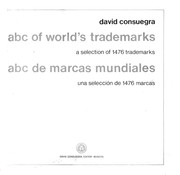
ABC of world's trademarks
By David Consuegra
Subjects: Graphic Design, trademarks, marcas comerciales, diseño gráfico
Description: INTRODUCTION Of all the tasks a graphic designer has to face and solve, that of designing a trademark is without doubt the one which implies the greatest effort to achieve synthesis and clarity. This, for several reasons. First of all, the use of lettering as a structural basis implies absolute readability. Secondly —and because of the first— he is obliged to seek particular graphic means to express a specific content, without diminishing the readability of the initial. Last of all, he must be commited to the image itself, apart from its content, in the search for an aesthetic solution which stimulates, in the observer's mind, a feeling of greatness, elegance and contemporaneous quality, and which has durability when competing with other images. Despite the surge of abstract designs in the field of commercial promotion, it is interesting to note that the trademark continues to offer clearer, more precise and more memorable solutions, thanks to the dual relation of form and content. Even more noteworthy is the intense search carried out by the graphic designer in solving the forementioned difficulties, as can be seen in the examples chosen. One might mention that there are three basic variants in the typology of trademarks: — The first uses lettering with a particular structure which enables it to distance itself from textual reading and to acquire an autonomous character as a figure. — The second goes beyond the mere shape of lettering and by using turns, cuts and repetitions, a result is reached which evokes the content which it represents. — The third uses figures unrelated to lettering itself and achieves an integration of form and content, creating an element which competes with the symbol; the symbol-trademark. The selection which was carried out was neither easy nor casual. On the contrary, quite some time was needed to obtain complete information based on the few publications which exist on the subject. There are still numerous gaps such as nationality of the firm, type of activity, the designer, his nationality and date of execution. As editor, I hope to be able to fill-in these gaps in a future edition. The selection was made on the basis of the alphabet and of the most frequently occurring letter combinations. The absence of other combinations is due to the design of the book itself, as the idea was to try and find at least a sufficient variety of solutions to fill each page. David Consuegra
Comments
You must log in to leave comments.